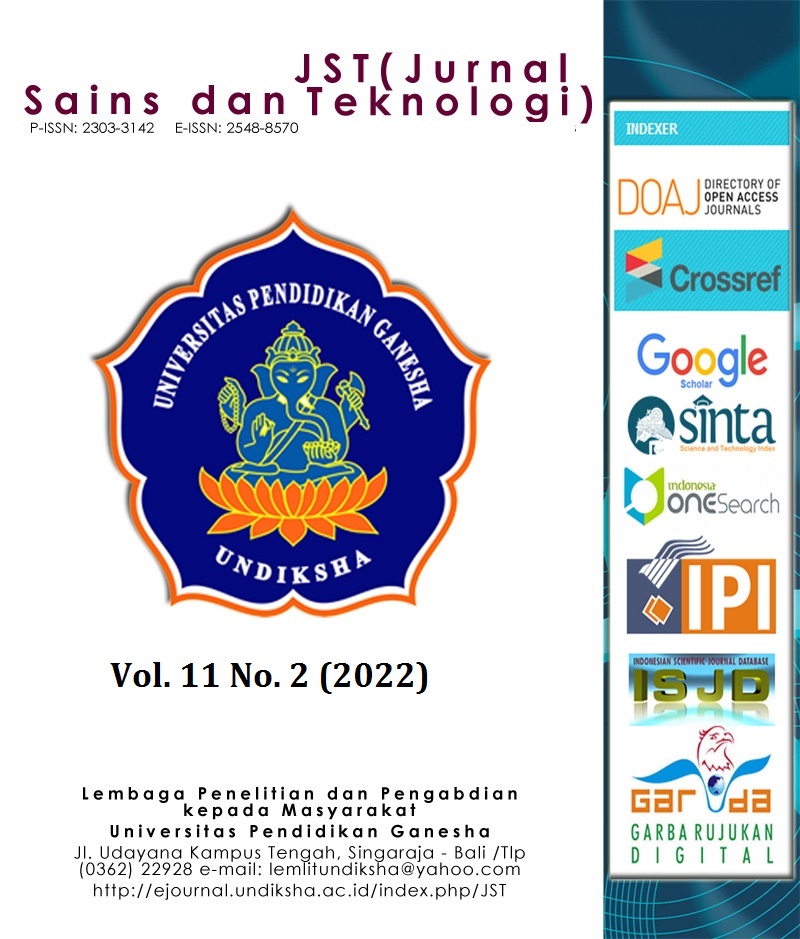PEMBUATAN RICE PAPER BERAS MERAH DENGAN SUBSTITUSI TEPUNG PORANG
DOI:
https://doi.org/10.23887/jstundiksha.v11i2.45846Kata Kunci:
Rice paper, Tepung porang, Tepung tapioka, Beras merahAbstrak
Rice paper is a rice-based food product that is currently popular in various Asian countries. Brown rice has various advantages over white rice, it contains flavonoid (anthocyanins) as antioxidants and also brown rice has a high fiber. Porang flour is an alternative food that is low in fat and high in fiber. This research is a descriptive experimental research design that aims to analyze the organoleptic characteristics, acceptability, content of macronutrients and fiber of the innovative product of making red rice rice paper with porang flour substitution. This study uses 3 formulas, namely the addition of brown rice, (tapioca flour and porang flour with different levels). The experiment was repeated twice on the same 30 panelists. The three samples were tested proximately (carbohydrate, protein, fat, ash content, fiber content, and water content). The data were analyzed using the Friedman Test on the four indicators including color, aroma, taste, and texture the results is significance value (p = 0.0001) < (0.05) which can be interpreted as all indicators (color, aroma, texture, and taste) has a real difference. The conclusion of this study is that rice paper F3 has the highest average value (the most preferred formula for the general public panelists).Referensi
Anggraini, P. N., Susanti, S., & Bintoro, V. P. (2019). Karakteristik fisikokimia dan organoleptik bakso itik dengan tepung porang sebagai pengenyal. Jurnal Teknologi Pangan, 3(1), 155–160. https://doi.org/10.14710/jtp.v3i1.23533.
Ardiansyah, G., Hintono, A., & Pratama, Y. (2019). Karakteristik Fisik Selai Wortel (Daucus carota L.) dengan Penambahan Tepung Porang (Amorphophallus oncophyllus) sebagai Bahan Pengental. Jurnal Teknologi Pangan, 3(2), 175–180. https://doi.org/10.14710/jtp.v3i2.23520.
Arysanti, R. D., Sulistiyani, S., & Rohmawati, N. (2019). Indeks Glikemik, Kandungan Gizi, dan Daya Terima Puding Ubi Jalar Putih (Ipomoea batatas) dengan Penambahan Buah Naga Merah (Hylocereus polyrhizus). Amerta Nutrition, 3(2), 107. https://doi.org/10.20473/amnt.v3i2.2019.107-113.
Dermawan, R., Erfiani, & Rizki, A. (2018). Statistical Process Control pada Pengujian Kestabilan Alat Pengukur Kadar Glukosa Darah Non-Invasif. Xplore: Journal of Statistics, 2(1), 41–48. https://doi.org/10.29244/xplore.v2i1.77.
Djajati, S., & Palupi, T. (2018). Es Krim Susu Biji Kecipir (Psophocarous Tertragonolobus L.) Dengan Penambahan Tepung Glukomanan Dan Virgin Coconut Oil. Jurnal Teknologi Pangan, 11(2). https://doi.org/10.33005/jtp.v11i2.893.
Lestari, S. (2016). Kajian Pengolahan Tepung Mocaf pada Empat Varietas Ubi Kayu Menggunakan Starter Bimo-CF dan Lama Perendaman 18 Jam. Prosiding Seminar Nasional Agroinovasi Spesifik Lokasi Untuk Ketahanan Pangan Pada Era Masyarakat Ekonomi ASEAN, 216–227.
Lv, P., Song, L., Li, Y., Pang, H., & Liu, W. (2021). Hybrid ternary rice paper/polypyrrole ink/pen ink nanocomposites as components of flexible supercapacitors. International Journal of Hydrogen Energy, 46(24), 13219–13229. https://doi.org/10.1016/j.ijhydene.2021.01.111.
Mahirdini, S., & Afifah, D. N. (2016). Pengaruh substitusi tepung terigu dengan tepung porang (amorphophallus oncopphyllus) terhadap kadar protein, serat pangan, lemak, dan tingkat penerimaan biskuit. Jurnal Gizi Indonesia (The Indonesian Journal of Nutrition), 5(1), 42–49. https://doi.org/10.14710/jgi.5.1.42-49.
Pasaribu, G. T., Hastuti, N., Efiyanti, L., Waluyo, T. K., & Pari, G. (2019). Optimasi teknik pemurnian glukomanan pada tepung porang (Amorphophallus muelleri blume). Jurnal Penelitian Hasil Hutan, 37(3), 197–203. https://doi.org/10.20886/jphh.2019.37.3.197-203.
Perdani, C., Mawarni, R. R., Mahmudah, L., & Gunawan, S. (2022). Prinsip-Prinsip Bahan Tambahan Pangan Yang Memenuhi Syarat Halal: Alternatif Penyedap Rasa Untuk Industri Makanan Halal. Halal Research Journal, 2(2), 96–111. https://doi.org/10.12962/j22759970.v2i2.419.
Putriningsih, A. A., Surjoseputro, S., & Setijawati, E. (2018). Pengaruh Konsentrasi Tapioka pada Beras Varietas Mentik (Oryza sativa var. Mentik) terhadap Sifat Fisikokimia Rice Paper. Jurnal Teknologi Pangan Dan Gizi, 17(1), 28–35. https://doi.org/10.33508/jtpg.v17i1.1699.
Saputro, B. W., Dewi, E. N., & Susanto, E. (2018). Karakteristik edible film dari campuran tepung semirefined karaginan dengan penambahan tepung tapioka dan gliserol. Jurnal Pengolahan Dan Bioteknologi Hasil Perikanan, 6(2), 1–6. https://ejournal3.undip.ac.id/index.php/jpbhp/article/view/20236.
Sineke, J., & Mirna, K. (2020). Pemberian Makanan Ringan (Biskuit) Berbahan Dasar Pangan Lokal Tepung Tulang Ikan Malalugis (Decapterus spp) dan Bihun dalam Meningkatkan Status Gizi Anak Balita Stunting Usia 1-2 Tahun. Gizido, 12(2), 87–98. https://doi.org/https://doi.org/10.47718/gizi.v12i2.1226.
Tester, R., & Al-Ghazzewi, F. (2017). Glucomannans and nutrition. Food Hydrocolloids, 68, 246–254. https://doi.org/10.1016/j.foodhyd.2016.05.017.
Yanuriati, A., Marseno, D. W., Rochmadi, & Harmayani, E. (2017). Characteristics of glucomannan isolated from fresh tuber of porang (Amorphophallus muelleri Blume). Carbohydrate Polymers, 156, 56–63. https://doi.org/10.1016/j.carbpol.2016.08.080.
Unduhan
Diterbitkan
Cara Mengutip
Terbitan
Bagian
Lisensi
Hak Cipta (c) 2022 Elfira Maya Sari, Claudia Vida Vida, Denissa Azalia Diva, Devina Aulia Putri

Artikel ini berlisensiCreative Commons Attribution-ShareAlike 4.0 International License.
Authors who publish with the Jurnal Sains dan Teknologi (JST) agree to the following terms:
- Authors retain copyright and grant the journal the right of first publication with the work simultaneously licensed under a Creative Commons Attribution License (CC BY-SA 4.0) that allows others to share the work with an acknowledgment of the work's authorship and initial publication in this journal.
- Authors are able to enter into separate, additional contractual arrangements for the non-exclusive distribution of the journal's published version of the work (e.g., post it to an institutional repository or publish it in a book), with an acknowledgment of its initial publication in this journal.
- Authors are permitted and encouraged to post their work online (e.g., in institutional repositories or on their website) prior to and during the submission process, as it can lead to productive exchanges, as well as earlier and greater citation of published work. (See The Effect of Open Access)
















